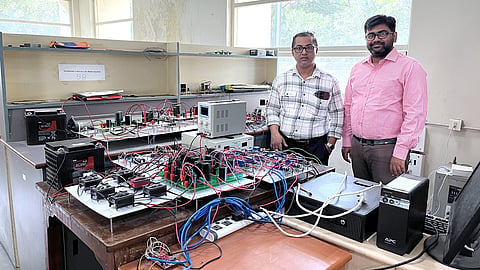

National Institute of Technology (NIT) Rourkela, researchers have developed an intelligent control system that can automatically manage the electricity flow from solar, wind, and battery sources.
This innovative 'hybrid microgrid' can deliver clean and continuous power supply to areas in the countryside that have no access to the main electric power grid.
The findings of this research have been published in the journal IEEE Transactions on Industry Applications in a paper co-authored by Prof. Arnab Ghosh, in collaboration with Prof. Krishna Roy, Assistant Professors, Department of Electrical Engineering, and Ms. Ananya Pritilagna Biswal, Research Scholar, NIT Rourkela.
The primary aim of this research is to reduce the potential use of fossil fuel reserves and provide power to remote regions that are not covered by the main electricity grid.
The research supports multiple Sustainable Development Goals, including Clean and Affordable Energy (SDG 7), Climate Action (SDG 13), and Sustainable Communities (SDG 11).
Hybrid microgrids are being researched worldwide, wherein renewable energy sources such as solar and wind power are combined with battery storage.
However, the integration remains complicated and prone to fluctuations. Such fluctuations can lead to unstable supply and even interruptions in the power provided.
To address this issue, NIT Rourkela researchers developed a dynamic Power Management Scheme (PMS) that enables all energy producers and storage units to coordinate seamlessly.
This controlling technique allows the batteries to store energy safely and efficiently, enabling greater storage capacity and longer battery life, while reducing overall expenditures.
By automatically switching converters according to the most readily available resources, solar in the morning, and wind, Biomass Gasifier (BMG), and Pico Hydropower (PH) during the rest of the day, the system ensures that the active power flow is balanced across different loads.
This multi-source converter-based hybrid setup, which is hardly ever present in current markets, can provide an effective solution for the needs of remote communities and can be a source of approximately 10 kWh of dependable energy, sufficient for four households in rural areas.
The researchers have shown that their system works under several real-world scenarios, such as fluctuating solar radiation, changing wind speeds, and varying electrical loads.
Apart from microgrids, the proposed system would also be effective in microgrids, electric vehicle charging stations, and Standalone renewable energy systems.
Decentralised power generation systems that strengthen the distribution of renewable energy within the country help achieve NIT Rourkela's mission.
This strategy helps NIT Rourkela get even closer to providing reliable green energy access for all households, particularly those in rural and off-grid areas.
